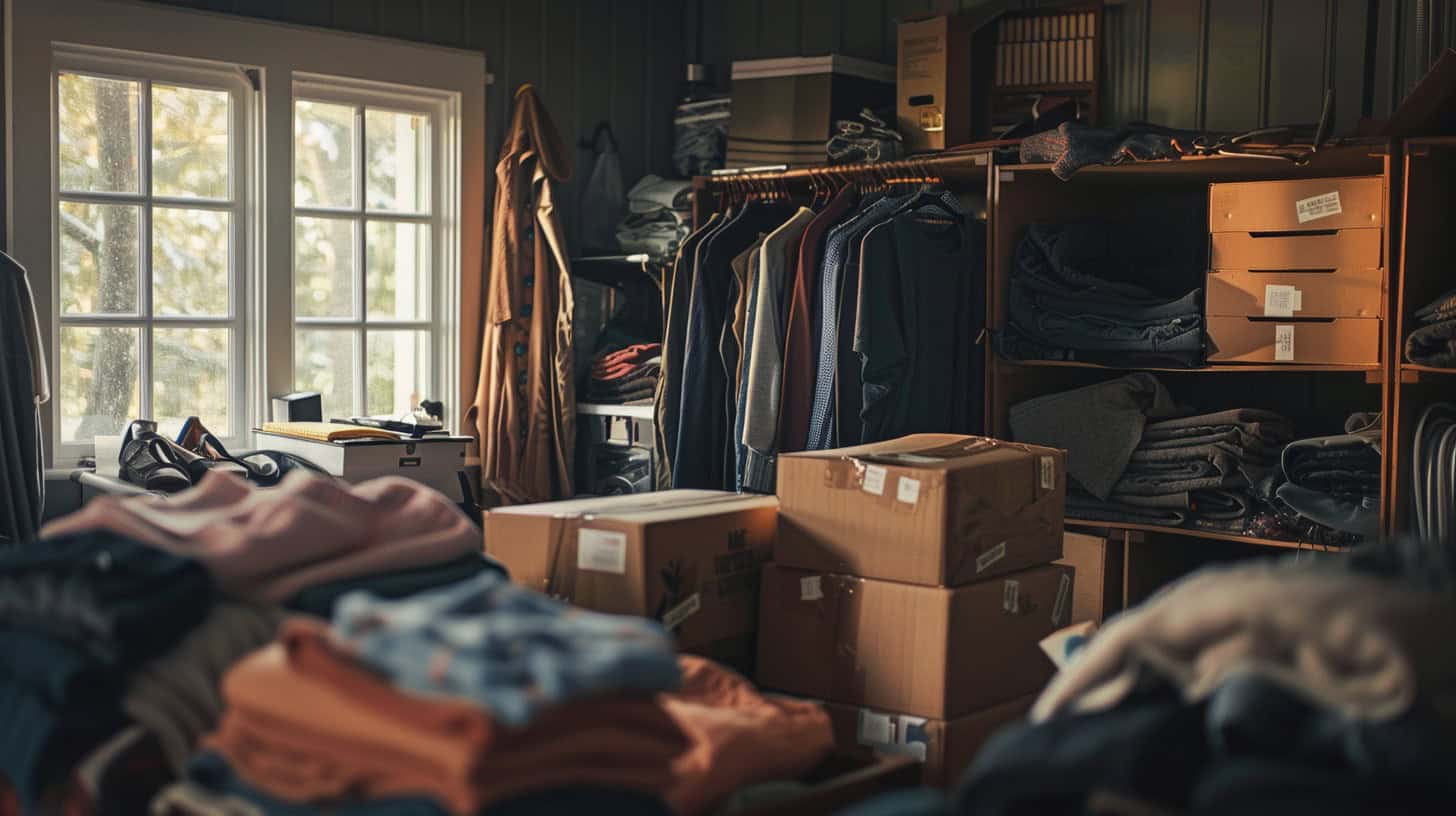Moving can be a hassle. Packing clothes often causes stress. But it doesn’t have to. With the right approach, you can turn this chore into a game. This guide offers 15 gamified tips to make packing clothes fun and efficient.
You’ll learn how to use wardrobe boxes, vacuum-sealed bags, and other tools to maximize space and minimize wrinkles. 3
As a professional organizer with 10 years of experience, I’ve helped countless men streamline their moves. I’ve seen firsthand how the right packing methods can save time and reduce stress.
From selecting clothes to keep, to organizing for easy unpacking, this guide covers it all. Ready to level up your packing skills? 1
Key Takeaways
Sort clothes before packing, keeping only items worn in the last year and donating or selling the rest to reduce clutter.
Use wardrobe boxes with built-in hanging rods to keep suits, dresses, and dress shirts wrinkle-free during the move.
Vacuum-sealed bags can compress bulky items like winter coats by up to 75%, saving valuable space.
Roll casual clothes like t-shirts and jeans to save space, and fold dress shirts and slacks to minimize wrinkles.
Pack a “moving day suitcase” with 2-3 days of clothes, toiletries, and essentials for easy access during the transition.
Table of Contents
Preparing Your Clothes for Packing
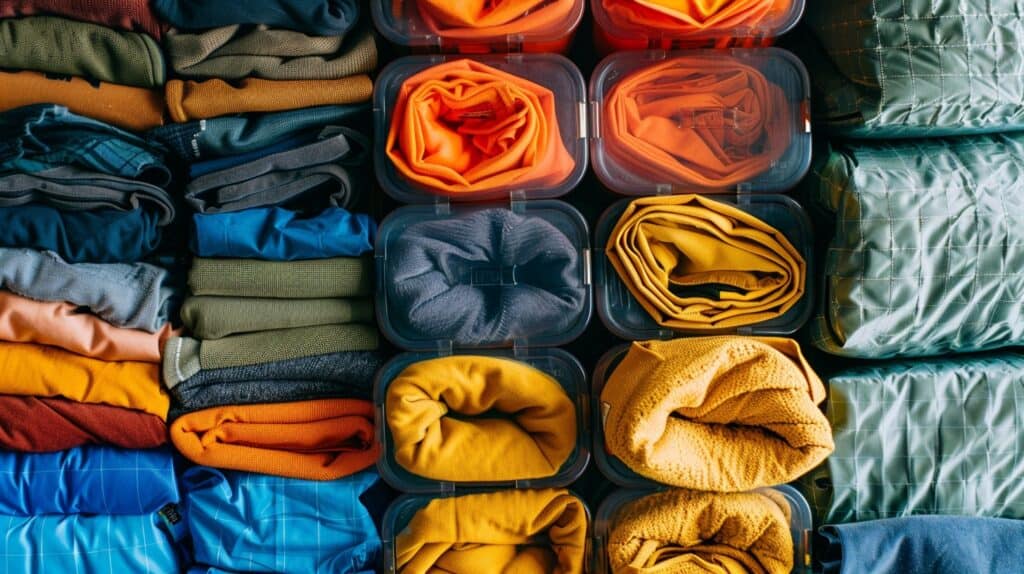
Get ready to streamline your move. Start by sorting your clothes and deciding what to keep or donate.
Selecting Clothes to Keep
Selecting the right clothes to keep during a move streamlines the process and reduces clutter in your new home. Men can follow these practical tips to make smart decisions about their wardrobe:
- Keep only items worn in the last year – this rule helps eliminate rarely used pieces
- Assess condition – discard damaged or worn-out clothing beyond repair
- Focus on versatile basics – retain staples like solid t-shirts, jeans, and dress shirts
- Evaluate fit – remove clothes that no longer fit properly
- Consider lifestyle changes – keep items suitable for your current or future activities
- Retain sentimental pieces – save meaningful garments like team jerseys or gifts
- Donate gently-used clothes to Goodwill or Salvation Army
- Sell trendy or high-demand items through consignment stores or online platforms
- Sort clothes by season – pack off-season items separately for easier unpacking. 1
- Limit duplicates – keep only a reasonable number of similar items. 2
Washing and Sorting by Type
Proper cleaning and organization set the stage for efficient packing. Tackle this crucial step with these straightforward tips:
- Launder all clothes before packing to prevent odors and stains
- Sort garments by type: shirts, pants, underwear, socks 1
- Group items by season: summer, winter, spring/fall
- Separate delicates and dry-clean-only pieces
- Create piles for each family member
- Use fabric softener sheets between layers for freshness
- Remove dry-cleaned items from plastic bags
- Check pockets for forgotten items
- Repair any damaged clothing before packing
- Roll casual items like t-shirts and jeans to save space
- Fold dress shirts and slacks to minimize wrinkles
- Pack shoes separately to avoid soiling clothes
- Use vacuum bags for bulky items like sweaters and coats
- Keep frequently worn items accessible in a suitcase
- Label boxes clearly with contents and destination room 3
Selecting Suitable Packing Materials

Choosing the right packing materials can make or break your move. Go for sturdy cardboard boxes and vacuum-sealed bags to keep your clothes safe and compact.
Using Cardboard Boxes
Cardboard boxes are the workhorses of moving clothes. They’re cheap, sturdy, and easy to stack. Regular moving boxes fit non-hanging clothes, shoes, and smaller items perfectly. 1 For delicate items, lay-flat boxes offer extra protection.
Vacuum-sealed bags and packing materials like bubble wrap help maximize space and prevent wrinkles. 1
The right box makes all the difference in a smooth move.
Cheap local movers often provide boxes, but buying your own ensures quality. 4 Pack heavier items at the bottom, lighter on top. Fill gaps with socks or underwear to prevent shifting.
Label each box clearly with its contents and destination room. Next, let’s explore the benefits of vacuum-sealed bags for efficient packing.
Choosing Vacuum-Sealed Bags
Vacuum-sealed bags are game-changers for packing clothes. These space-savers compress bulky items like jackets and winter coats, reducing their volume by up to 75%. 5 They also shield your garments from moisture and dirt during the move.
For optimal results, pack similar fabrics together and remove excess air gradually to avoid wrinkles.
Men often overlook the benefits of vacuum bags for moving. They’re perfect for storing out-of-season clothes, freeing up valuable box space for everyday wear. Pro tip: Leave a small opening when sealing to avoid over-compression, which can damage delicate fabrics.
Always check the bag’s size limits before packing to ensure a snug, secure fit. 6
Opting for Wardrobe Boxes
Wardrobe boxes offer a game-changing solution for moving men’s clothing. These tall boxes come with built-in hanger bars, allowing suits, dress shirts, and jackets to stay wrinkle-free during transport. 5 Wardrobe boxes cost more than standard packing boxes but deliver unmatched convenience. They eliminate the need to fold or stuff hanging clothes into bags or suitcases.
For efficiency, pack shoes and accessories in the bottom of wardrobe boxes. This maximizes space usage and keeps related items together. Label each box clearly with its contents and destination room to streamline unpacking.
While pricier, wardrobe boxes safeguard your clothing investment and save time on both ends of the move. 6
Packing with Suitcases and Duffel Bags
Suitcases and duffel bags offer versatile options for packing clothes during a move. These containers protect garments from dust and damage while maximizing space. 6 Roll shirts, pants, and sweaters into tight cylinders to fit more items and reduce wrinkles.
Stuff shoes with socks or underwear to maintain their shape and save room.
Pack smart, move easy.
Use soft clothes as padding for fragile items within your luggage. Place heavier items at the bottom and lighter ones on top to prevent crushing. Secure zippers with small locks for added security during transport.
Label each bag clearly with your name and destination to avoid mix-ups. 5
Techniques for Packing Foldable Clothes
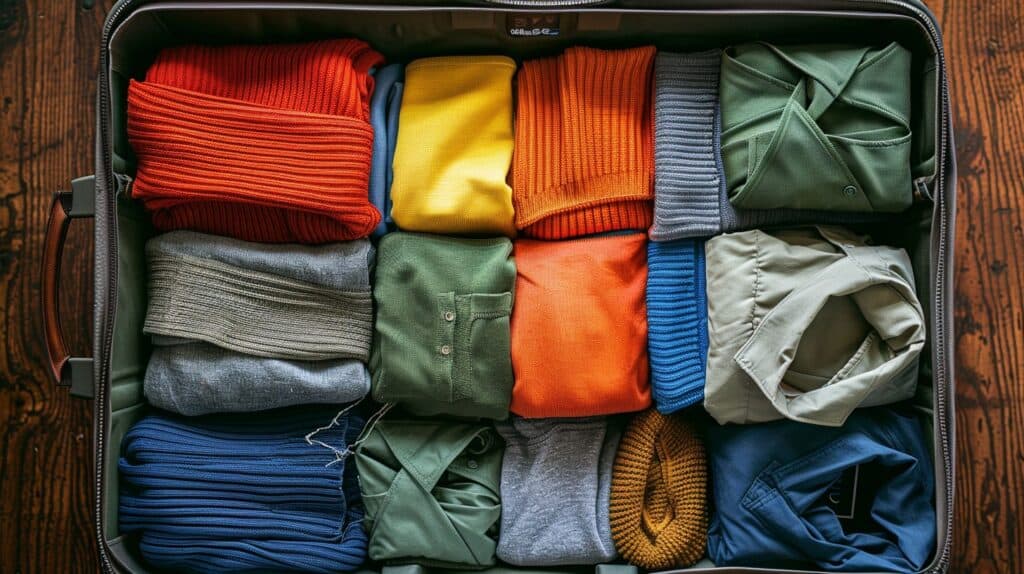
Mastering the art of folding clothes can save space and prevent wrinkles. Learn more about efficient packing techniques….
Effective Folding Methods to Maximize Space
Efficient folding techniques save space and prevent wrinkles during moves. These methods optimize packing for a smooth transition to your new home.
- Military Roll Method: Lay clothes flat, fold in sleeves, roll tightly from bottom to top. This compact technique reduces wrinkles and maximizes space in suitcases or boxes. 1
- KonMari Folding: Fold garments into rectangles, then stand them upright in drawers or containers. This vertical storage allows easy visibility and access to all items.
- Flat Fold Method: Stack similar items (shirts, pants) together, folding each piece neatly. This traditional approach works well for dresser drawers and flat storage spaces.
- Bundle Wrapping: Wrap smaller items inside larger ones, creating a bundle. This method protects delicate fabrics and utilizes space efficiently in luggage.
- Compression Bags: Use vacuum-sealed bags for bulky items like sweaters or comforters. This technique dramatically reduces volume, freeing up valuable moving space.
- Folding Dress Shirts: Lay shirt face down, fold sleeves inward, fold sides to center, then fold bottom to top. This minimizes creases for formal wear. 2
- Packing Cubes: Organize clothes by type or outfit in separate cubes. This system keeps items compact and easy to locate after moving out.
- Folding Jeans: Fold in half lengthwise, then fold legs up to waistband. This method creates a compact square that fits neatly in boxes or drawers.
Utilizing Vacuum Bags for Bulky Garments
Folding methods maximize space, but vacuum bags take it further. These storage solutions compress bulky garments, saving space and protecting clothes.
- Vacuum bags reduce volume by up to 75% for sweaters, jackets, and out-of-season clothes. 5
- Use bags to store more items in less space and shield garments from moisture and dirt. 1
- Select heavy-duty bags with durable zippers to prevent air leaks
- Group similar items together – winter coats in one bag, sweaters in another
- Remove excess air with a vacuum cleaner or hand pump for maximum compression
- Label each vacuum bag clearly with contents and season for easy identification
- Store compressed bags in suitcases or boxes for added protection during the move
- Avoid over-packing bags to prevent damage to zippers or seals
- Use vacuum bags for bedding, pillows, and other soft goods to maximize space savings
Methods for Packing Clothes on Hangers

Wardrobe boxes are a game-changer for moving hanging clothes… Keep reading to learn more tips and tricks for hassle-free packing!
Employing Wardrobe Boxes for Hanging Clothes
Wardrobe boxes are game-changers for moving in together. These tall, sturdy containers come with built-in hanging rods, perfect for suits, dresses, and dress shirts. 1 They keep clothes wrinkle-free and ready to wear upon arrival.
Guys, imagine unpacking your favorite blazer without a crease in sight.
A well-packed wardrobe box is like a mobile closet – organized and efficient.
Using wardrobe boxes is simple. Hang your clothes directly on the rod, just like in your closet. 5 For bulky items like winter coats, use padded hangers to maintain shape. Don’t forget to utilize the bottom space for shoes or folded items.
Next, let’s explore alternatives for hanging clothes when wardrobe boxes aren’t available.
Alternatives: Using Trash Bags or Garment Bags
If wardrobe boxes aren’t your style, trash bags and garment bags offer practical alternatives. Trash bags provide a quick, budget-friendly option for multiple hanging clothes. Simply group 10-15 hangers, pull a bag over them from the bottom, and tie it at the top. 5 Garment bags excel for pricier or delicate items. They shield clothes from dust and wrinkles during transit. 6 Both methods keep garments on hangers, speeding up the unpacking process.
For longer moves, opt for garment bags to ensure better protection.
Strategies for Packing Shoes and Accessories
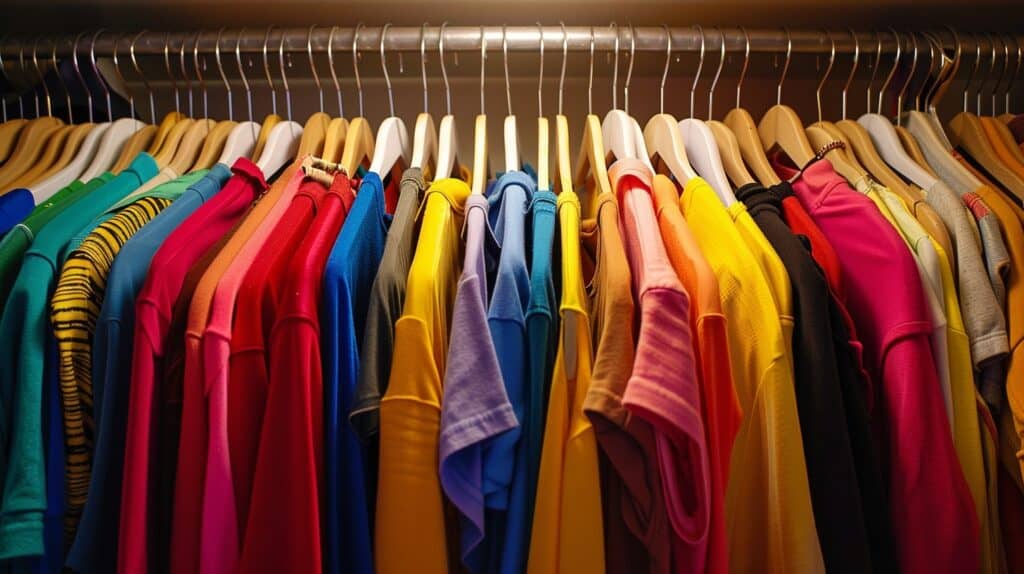
Packing shoes and accessories needs smart planning. Stuff your footwear to keep its shape. Sort small items into clear bags for easy access. Want more tips? Keep reading!
Preserving Shoe Shape with Stuffing
Proper shoe care during a move ensures your footwear arrives in top condition. Here are key tips for preserving shoe shape with stuffing:
- Use clean socks or balled-up paper to fill shoes, maintaining their form. 7
- Employ shoe trees for leather shoes to prevent creases and maintain structure.
- Stuff boots with rolled-up magazines to keep shafts upright.
- Insert foam toe forms in athletic shoes to prevent crushing.
- Place acid-free tissue in dress shoes to absorb moisture and prevent odors.
- Utilize cedar shoe shapers for loafers and slip-ons to combat mildew.
- Fill high heels with crumpled packing paper to support the arch. 8
- Stuff sneakers with newspaper to absorb excess moisture during transit.
- Insert plastic water bottles in tall boots to maintain leg shape.
- Use bubble wrap in delicate dress shoes for extra cushioning.
Organizing Jewelry and Small Accessories
Moving from shoe care to accessory organization requires equal attention to detail. Proper storage of jewelry and small accessories prevents damage and simplifies unpacking.
- Use small containers or pouches for individual pieces to avoid tangling 1
- Wrap delicate items in acid-free tissue paper for protection
- Store necklaces through straws to prevent knots 9
- Place cufflinks and tie clips in pill organizers for easy access
- Use egg cartons to separate and cushion small items
- Roll belts and secure with rubber bands
- Pack watches in socks for cushioning
- Use plastic wrap to keep jewelry sets together
- Thread earrings through buttons to keep pairs united
- Employ tackle boxes for organizing multiple small accessories
- Utilize sunglass cases for storing fragile pieces
- Pack scarves in vacuum-sealed bags to save space
- Use bubble wrap for extra protection of valuable items
- Place tie bars in between pages of a hardcover book
- Store collar stays in a dedicated card holder for safekeeping
Special Packing Considerations
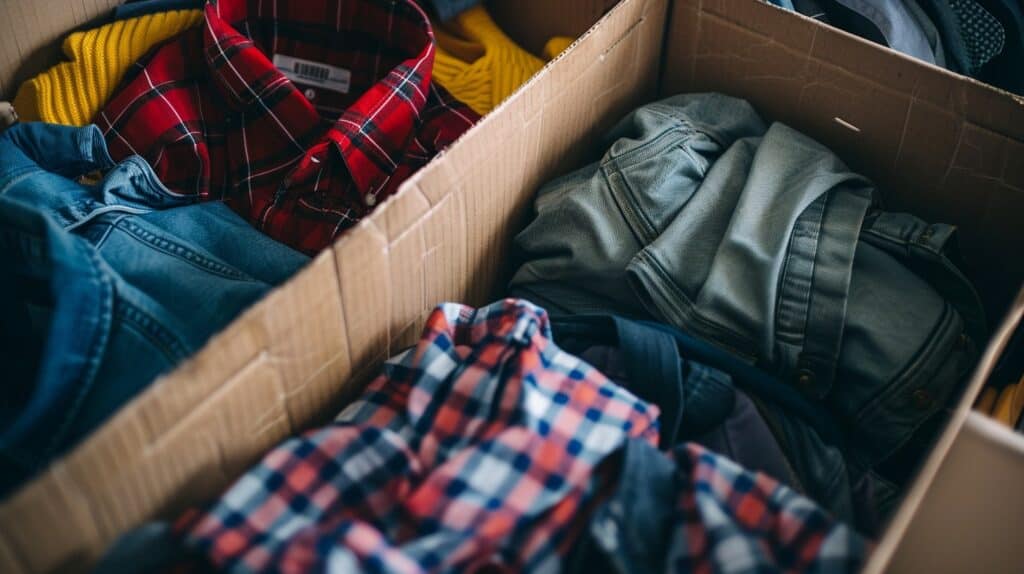
Delicate garments need extra care… Want to know how to keep your clothes fresh during the move? Read on for more tips!
Protecting Delicate Garments
Delicate garments need special care during a move. Wrap beaded or sequined items in bubble wrap for extra protection. 1 Use garment bags or acid-free tissue paper to shield valuable clothing from dust and damage.
Stuff sleeves and bodices with tissue to maintain shape. Pack these items separately in sturdy boxes labeled “Fragile.” Avoid stacking heavy objects on top of boxes containing delicate clothes. 10 For expensive suits or designer pieces, consider using wardrobe boxes with built-in hanging rods. This method keeps clothes wrinkle-free and ready to wear upon arrival at your new place.
Maintaining Freshness with Scented Sachets
Scented sachets pack a powerful punch in keeping clothes fresh during moves. 1 Lavender, cedar chips, or dryer sheets tucked into boxes or vacuum bags fight musty odors. These fragrant helpers also reduce bulk – a win-win for space-saving and freshness.
Guys, toss a few sachets in with your shirts and pants. Your clothes will arrive at the new place smelling great, not like cardboard or mothballs. 11
Organizing Clothes for the Move

Organizing your clothes for the move can make unpacking a breeze. Pack a “first-day” bag with essentials… Want more smart packing tips? Keep reading!
Preparing a Moving Day Suitcase
Preparing a moving day suitcase ensures easy access to essentials during the transition. This strategy minimizes stress and keeps necessities within reach.
- Pack clothes for 2-3 days, including underwear and socks
- Include toiletries: toothbrush, toothpaste, deodorant, razor
- Add a towel and washcloth for quick clean-ups
- Throw in phone chargers and essential electronics
- Pack any daily medications or health items
- Include important documents like IDs and moving paperwork
- Add a basic first-aid kit for emergencies
- Pack a few snacks and a water bottle
- Include a multi-tool or small toolkit for quick fixes
- Add a flashlight and spare batteries
- Pack a set of bedsheets and pillowcase for the first night
- Include a change of shoes suitable for moving activities
- Add entertainment items like a book or tablet
- Pack a small laundry bag for used clothes
- Include cash for unexpected expenses or tips
Next, we’ll explore efficient methods for organizing clothes to streamline the unpacking process. 15
Arranging Clothes for Efficient Unpacking
After preparing your moving day suitcase, it’s time to tackle the rest of your wardrobe. Efficient unpacking starts with smart packing.
- Group similar items: Pack shirts with shirts, pants with pants. This simplifies unpacking and organizing. 4
- Use clear containers: See-through bins let you spot items quickly without opening boxes.
- Create a clothing map: List contents on each box’s exterior. This saves time when searching for specific items.
- Pack by season: Store off-season clothes separately. Unpack current season items first for immediate use.
- Implement a color-coding system: Assign colors to different clothing types or rooms. This speeds up the unpacking process.
- Roll casual clothes: T-shirts, sweatshirts, and tank tops take up less space when rolled.
- Hang delicate items: Use wardrobe boxes for suits, dress pants, and blouses to prevent wrinkles. 1
- Vacuum-seal bulky items: Compress winter coats and quilts to save space and protect from dust.
- Pack shoes separately: Use shoe boxes or plastic bins to keep footwear clean and organized.
- Keep accessories accessible: Store jewelry and small items in clear, labeled containers for easy retrieval.
Final Packing Tips
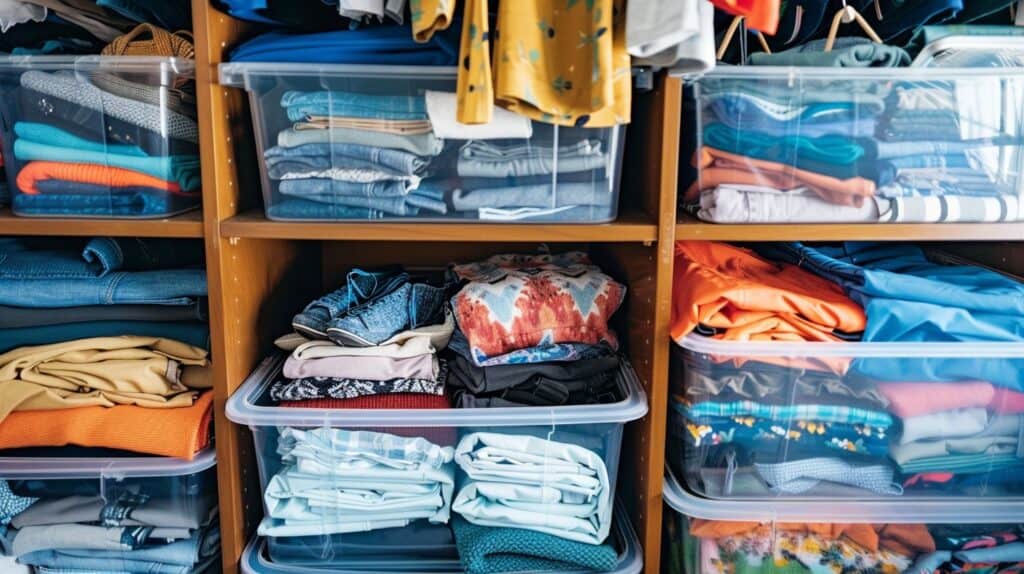
Final Packing Tips: Label your boxes and keep an inventory – it’ll save you headaches later. Want more moving hacks? Keep reading!
Labeling Your Boxes Clearly
Clear labeling saves time and stress during your move. Grab a permanent marker and write the contents and destination room on each box. “Kitchen – Plates” or “Bedroom – T-shirts” work well.
Don’t forget to mark fragile items. This system makes unpacking a breeze and helps movers place boxes in the right rooms. 12
For extra organization, use color-coded labels or numbering. Assign each room a color or number, then mark boxes accordingly. Create a master list with box numbers and contents for quick reference.
This method streamlines the process and ensures nothing gets lost in the shuffle. 1
Maintaining a Detailed Inventory of Packed Items
Labeling boxes clearly sets the stage for efficient unpacking. A detailed inventory takes this organization to the next level. Create a spreadsheet or use an app to list every item packed.
Include box numbers, contents, and destination rooms. This system helps track belongings and speeds up the unpacking process. It’s especially useful for locating specific items quickly in your new home. 13
An inventory safeguards against loss or damage during transit. Document valuable items with photos and serial numbers. This record proves invaluable for insurance claims if needed.
Keep a digital copy of your inventory in the cloud for easy access. A thorough list ensures nothing gets left behind or misplaced during your move. 1
People Also Ask
What’s the best way to pack clothes for moving?
Use the flat-fold method for wrinkle prevention. Roll casual items. Vacuum-seal bulky clothes. Pack delicates in hat boxes. Store furs separately.
How can I make packing clothes fun?
Turn it into a game. Challenge yourself to pack faster. Reward progress with shopping breaks. Use colorful storage boxes. Make it a fashion show.
Should I use a storage unit for my clothes?
Yes, if you have too many. Self-storage units protect seasonal wear. They’re great for furs and fancy outfits. Check affiliate links for deals.
What about packing linens and towels?
Roll them to save space. Use them as padding for fragile items. Vacuum-seal if possible. Keep a few out for moving day.
Any tips for organizing clothes while packing?
Sort by season and type. Use clear bins for easy viewing. Label everything. Keep an inventory. Donate what you don’t need before moving.
References
- ^ https://www.goarmstrong.com/resources/how-to-pack-clothes/
- ^ https://www.forbes.com/home-improvement/moving-services/how-to-pack-clothes-for-moving/
- ^ https://www.uhaul.com/Tips/Packing/How-To-Pack-Clothes-for-Moving-A-Step-By-Step-Guide-28524/
- ^ https://www.moving.com/tips/whats-the-best-way-to-pack-your-clothes/ (2019-01-28)
- ^ https://www.pods.com/blog/how-to-pack-clothes-for-a-move (2024-05-14)
- ^ https://www.usatoday.com/money/homefront/moving/how-to-pack-clothes-for-moving/
- ^ https://www.d1moving.com/blog/how-to-pack-shoes-for-moving
- ^ https://organized31.com/packing-moving-storing-shoes/ (2022-07-25)
- ^ https://diamondsinthelibrary.com/how-to-pack-jewelry-for-a-move/
- ^ https://www.moving.com/tips/packing-clothes-for-a-move-12-tips-you-need-to-know/ (2018-12-11)
- ^ https://roadwarriorette.boardingarea.com/2011/08/03/quick-packing-tip-use-a-sachet-for-freshness/
- ^ https://www.movinghelp.com/move/packing-tips-for-moving/ (2024-04-23)
- ^ https://www.architecturaldigest.com/reviews/moving/how-to-pack-clothes-for-moving
